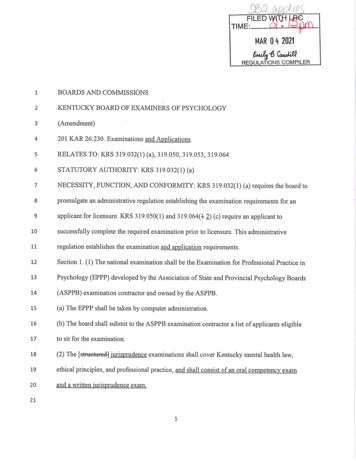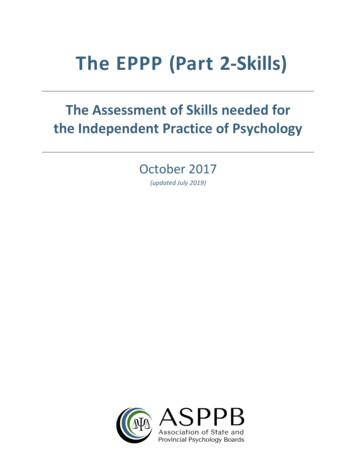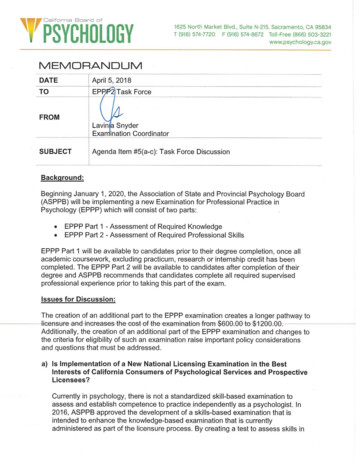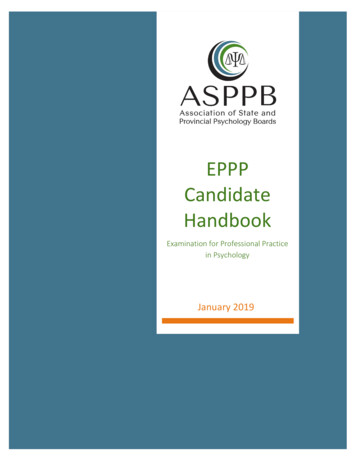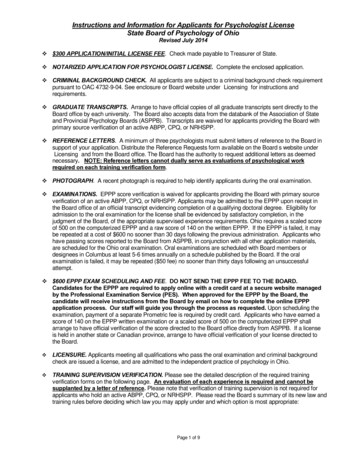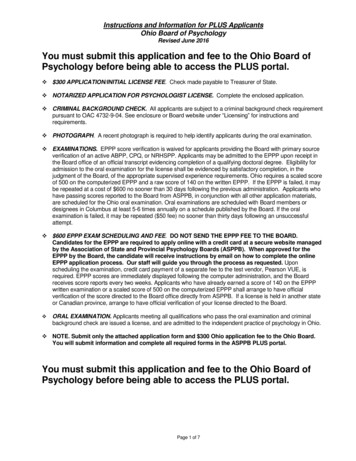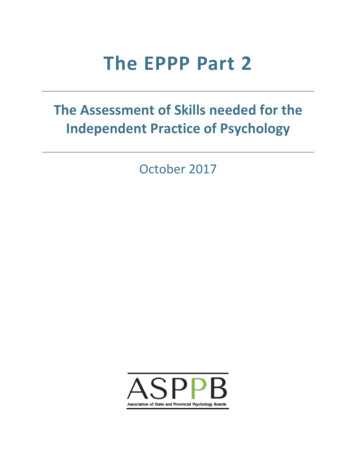
Transcription
The EPPP Part 2The Assessment of Skills needed for theIndependent Practice of PsychologyOctober 2017
The EPPP Part 2: The Assessment of Skills needed for theIndependent Practice of PsychologyTable of ContentsAn Overview of the Rationale for the EPPP Part 2 . 2Developing an Empirical Base for a Competency Model . 4Results of the Surveys and 2014 Competency Model: . 52016 Job Task Analysis . 6ASPPB Competencies Expected of Psychologists at the Point of Licensure . 7Comparison of Competency Models . 8Assessment of Competence . 8ASPPB Pyramid for the Assessment of Competence . 9Reviewing Methodologies to Assess Competency . 10Computer-Based Testing Procedures . 10Review of Competency Assessment Procedures Used by Other Professions . 10The Timeline for Skills Assessment in Psychology . 11EPPP Part 2 Exam Development Outline . 12APPENDIX A:ASPPB Competencies Expected of Psychologists at the Point of Licensure . 15APPENDIX B: Comparison of Competency Models . 21
An Overview of the Rationale for the EPPP Part 2Assessing competence to practice independently is a critical function of psychologylicensing boards and colleges throughout the United States and Canada. Competence is theintegrated and habitual use of knowledge, skills, attitudes, and values in psychology. Theevaluation and establishment of competence is necessary to ensure the protection of the public.Establishing competence is the key to ensuring that a professional is capable ofpracticing as part of the profession safely and effectively (Rodolfa et al., 2005).A current component of the profession’s assessment of readiness for independentpractice is a test of knowledge, the Examination for Professional Practice in Psychology(EPPP). The EPPP has served the profession well for over 50 years, but as the profession hasmoved toward embracing a culture of competence it has become clear that a standardizedmethod to assess the skills needed to practice independently is also required. Otherprofessions that embrace a culture of competence utilize knowledge-based and skills-based examsto determine readiness to practice independently.Currently there are a number of educational models used to train students in the fieldof psychology, many of which are accredited by the American Psychological Association (APA)and the Canadian Psychological Association (CPA). The APA and CPA accreditation systems donot require a prescribed course of education and training. Rather the focus of bothaccreditation systems is on ensuring that the core competencies for the profession are coveredas opposed to prescribing the means by which they are covered. Thus, there is diversity in howstudents are trained, resulting in sometimes vastly different levels of knowledge and skills instudents. ASPPB values these accreditation systems, and in fact has endorsed the position that“ graduation from an APA or CPA accredited program should be a minimum requirement fordoctoral level licensure for health service providers”.It should be noted that accreditation systems accredit training programs, notindividuals. As licensing boards license individuals, it is their duty to assure the public that eachindividual who is licensed is competent to practice independently.Evidence of a lack of standardization in training can be seen in the range of EPPP passrates for APA/CPA-accredited programs, which ranges from 13% to 100% (ASPPB, 2016).Additionally, as can be seen from summary data on the APPIC Application for PsychologyInternship, there is great variability in the type and quantity of practicum experiences that arerequired by accredited programs (APPIC, 2015, 2016). This variability in training models andexperiences results in students accruing anywhere from a few hundred hours, to severalthousand hours of practicum experience.Not all academic programs, internships or post-doctoral residencies are APA/CPAaccredited; thus, some individuals who become licensed have received training from programsthat have not been reviewed by an external agency. Students from these academic programs2
consistently underperform on the EPPP when compared to the average student from anaccredited doctoral program (Lightfoot, Rodolfa & Webb, 2016). This raises questions about theeffectiveness of the training provided by these programs, and suggests the importance ofprograms being reviewed by an external agency.Concern regarding the reliability and validity of supervisor written assessments oftrainees has been raised for years, and it has been demonstrated that supervisors tend tooverestimate their supervisees’ competence (e.g., Gonsalvez, 2007; Miller, Rodney, VanRybrock & Gregory, 1988). This tendency is perhaps the result of the inherent conflict of beingin gatekeeper and mentor roles simultaneously. The problem of supervisors overvaluing thecompetence of their supervisees led APPIC to change its format for intern letters of evaluationto encourage a more accurate evaluation of competence. APPIC requires supervisor letters toaddress the strengths and weaknesses of their trainees as opposed to a general statement oftheir performance. The issues of variability in ratings, a lack of standardization in the evaluativeprocess, and the questionable validity of supervisor ratings make it difficult for licensing boardsto attest to the competence of the psychologists they license. The EPPP Part 2 will provide anindependent, standardized, reliable, and valid assessment of the skills necessary forindependent practice.Critically, the profession of psychology’s move towards a “culture of competence” hasresulted in essential agreement among key stakeholder groups (e.g., APA’s CoA, CPA’s AP,ACPRO and ASPPB) regarding the necessary competencies for independent practice. Thisessential agreement was a necessary precondition to developing a skills examination. Lastly,the technology is now available to assess skills via a computer based examination, rather thanthe costlier and time-consuming examination using either real or standardized patients. Thus,ASPPB concluded that it is the optimal time to develop a standardized examination to assessthe functional skills necessary for independent practice.In January 2016, the Board of Directors (BOD) of the Association of State andProvincial Psychology Boards (ASPPB) approved the development of a skills-based exam.The skills exam will enhance the knowledge-based examination that is currentlyadministered as part of the licensure process. The first part of the new and enhanced EPPP willbe the knowledge-based exam, the current EPPP, and the second part will be the skills- based(functional skills) exam, the EPPP Part 2. With a test to assess skills in addition to the currenttest to assess knowledge, licensing boards will have available to them an enhanced EPPP thatwill offer a standardized, reliable and valid method of assessing competence.This document provides an overview of the development of the EPPP Part 2.3
Developing an Empirical Base for a Competency ModelThe historical efforts of the competency movement propelled the profession ofpsychology forward in its development of a conceptual basis for a competencies framework.ASPPB’s initial attempt to use empirical evidence to inform the development of a competencymodel occurred in 2009 with the work of the ASPPB Practice Analysis Task Force (PATF). Inaddition to the task of revalidating the knowledge domains of the EPPP, the PATF was chargedwith: 1) identifying and validating underlying professional competencies in psychology, and2) identifying assessment methods that would best measure these competencies. The goal ofthe EPPP practice analysis is to ensure that the exam reflects the knowledge necessary for competentpractice, and in doing so the public interest is protected.A competency model was proposed by the PATF based on the data obtained fromthe practice analysis. The PATF t h e n developed a survey regarding the practicecompetencies identified in the model, and randomly sampled 4732 licensed psychologistsfrom across Canada and the United States. Psychologists were asked to rate and commenton the relevance to the practice of psychology, of 37 competency statements and 276behavioral exemplars in the following clusters: Scientific Knowledge Foundational competencieso Evidence-based decision making/critical reasoning clustero Interpersonal and cultural competence clustero Professionalism/ethics cluster Functional competencieso Assessment clustero Intervention/supervision/consultation clusterSurvey respondents were asked to indicate the frequency with which theyperformed each competency in their practice during the previous year, the degree to whicheach competency was critical for optimizing outcomes for clients, and the importance ofeach competency to their psychology practice during the previous year. Respondents werealso asked to comment on the point in their development at which a psychologist should beable to demonstrate each behavioral exemplar.The ASPPB Competency Model and results of the survey were described in thePractice Analysis Report (ASPPB, 2010) and in an article written by members of the PATF(Rodolfa et al., 2013). The full report of the Practice Analysis is available on the ASPPB website.4
In 2010, the ASPPB Board of Directors appointed a task force to investigate thepossibility of developing a method to assess functional skills. The Competency AssessmentTask Force (CATF) used the PATF competency model as the basis of its continueddevelopment of an ASPPB Competency Model for Licensure. It reviewed the competencymodel, carefully exploring the data generated in the PAFT survey and comparing the modelwith other competency models, including the competency model utilized in Canada that ispart of the Mutual Recognition Agreement (MRA).The CATF developed criteria to focus the model to include only those competenciesand behavioral exemplars that are the most relevant and needed at the point of initiallicensure. The criteria chosen were based on empirical results from the PATF study. The CATFthen conducted an in-depth examination of each competency and its related behavioralexemplars, eliminating redundancies and rewording for clarity when necessary. This processresulted in a model with 6 competency clusters, 32 competencies and 97 behavioralexemplars.Once this was completed, the CATF sought the opinions stakeholders, conductingtwo surveys of the revised model of competency:CATF Regulator Survey: The CATF surveyed the ASPPB membership to determineregulators’ opinions regarding whether entry-level licensees/registrants should beable to demonstrate the 97 behaviors that defined in the model, and whether thesebehaviors are critical to public protection.CATF Training Director Survey: The CATF subsequently surveyed the A s s o c i a t i o nof Psychology Postdoctoral and Internship Centers ( APPIC)membership (internship and postdoctoral residency training directors) and APPICsubscribers (academic program directors) regarding the competency model. Helpfulratings were received about which behavioral exemplars they felt trainees wereexpected to demonstrate at three different developmental levels (end of internship,end of postdoctoral residency, and post-licensure).Results of the Surveys and 2014 Competency ModelSeventy regulators from 42 jurisdictions in the United States (81%) and 6jurisdictions in Canadian (60%) provided empirical support for the majority of the model.The data from the training director survey (N 216) substantially mirrored the results of theregulator survey, and also provided empirical support for the model. As a result of thesurvey feedback, the CATF made further modifications to the proposed ASPPB CompetencyModel and eliminated the Supervision competency. The model, ASPPB CompetenciesExpected at the Point of Licensure, was approved by the ASPPB BOD in 2014.5
2016 Job Task AnalysisAnother job task analysis (also known as a practice analysis) was initiated in 2016to revalidate the knowledge base for the EPPP Part 1 and to validate the current form ofthe competencies model to be used to provide the blueprint for the new exam, the EPPPPart 2. The Job Task Analysis Advisory Committee with the assistance of the exam vendor(Pearson Vue) analyzed the results of survey responses received from 2736 licensedpsychologists from across Canada and the USA. The responses were used to formulate the2017 version of the ASPPB Competencies Expected at the Point of Licensure. Therespondents, all of whom were practicing psychologists rated the competencies in the modelaccording to whether or not they are needed at the point of licensure, as well as on thecriticality and utility of each. The results validate the original competency model, with theaddition of a Supervision competency. Changes were made to the structure of the originalcompetency domains based on the data received and the feedback of the expert panel advisingthe job task analysis. Thus, there are different names for some of the domains in this latestiteration of the model (e.g., Professional Practice is focused on two major areas of practice Assessment and Intervention; Systems Thinking has been broadened to include Collaboration,Consultation and Supervision). While most of the language of the competencies and behavioralexemplars was retained, some of the actual competencies and behavioral exemplars wererefined, moved, clarified and updated, or deleted based on the data received. The commentsbelow provide an overview, and Appendix A contains the updated ASPPB competency modelwhich was empirically based on the input from these various sources. This model wasapproved by the ASPPB BOD in February, 2017. A full report of the 2016 Job Task Analysis isavailable on the ASPPB website.6
2017 ASPPB Competencies Expected of Psychologistsat the Point of LicensureThe 2017 version of the competency model contains the following competency domains:I. Scientific orientation: This competency domain involves an orientation to the knowledgedeveloped through the science of psychology, including evidence-based practice, as wellas a scientific method of looking at and responding to psychological problems. Thisgeneral competency also involves the knowledge of the core areas of psychology, whichwill not be assessed by the new competency part of the EPPP as they are currently wellassessed by the Part 1 of the Examination for Professional Practice in Psychology.2. Assessment and Intervention: This competency domain involves the provision ofpsychological assessment and intervention services to the public.3. Relational competence: This competency domain includes the ability to engage inmeaningful and helpful professional relationships, as well as to understand and interactappropriately in a variety of diverse cultural and social contexts. It includes the two subcategories of diversity and relationships.4. Professionalism: This competency domain includes personal competence, the ability toidentify and observe the boundaries of competence and reflective practice, the ability tobe self-reflective and to receive feedback from others in relationship to one’spsychological activities.5. Ethical practice: This competency domain involves the ability to apply both the ethicalcodes of the profession and the laws and regulations that govern the practice ofpsychology.6. Collaboration, Consultation, and Supervision: This competency domain involves the abilityto understand and work with individuals within broader systems and includes the skillsto operate effectively and ethically within organizational structures, to collaborate withothers in a cooperative, multidisciplinary manner and to effectively and ethically providesupervision to students, trainees and other professionals.Appendix A contains a complete list of competencies and the behavioral exemplarsthat were identified within each competency cluster.7
Comparison of Competency ModelsA comparison of the competency clusters articulated in the current ASPPBCompetency Model (2017), the competencies articulated in the Canadian MutualRecognition Agreement (MRA, 2004), and the competency model contained in the APACommission on Accreditation’s (CoA) Standards of Accreditation (2015) is presented inAppendix B. In comparing these three models, it is clear that there is substantial overlap atthe domain or cluster level of the models, as well as at the competency level. Thecomparison suggests that there is agreement among educators, practitioners, andregulators regarding the competencies required for the independent practice of psychology.Assessment of CompetenceMiller’s Pyramid (1990) is an assessment framework that was designed for use in theassessment of practitioner clinical skills, and was developed for use by the profession of medicine.This framework was adapted by the CATF to describe the developmental process thatpsychologists go through as they establish the competence necessary for independentpractice. The CATF’s adaptation of the Pyramid provides a simple representation of themanner in which the practice competencies develop, and provides a useful rubric for theirassessment. As displayed in Figure 1, the first and foundational stage in the pyramid is“KNOWS”, the second is “KNOWS HOW”, the third is “SHOWS HOW”, and the fourth andfinal level is “DOES”.The EPPP Part 1 is a test of core knowledge in the profession, and in essence forms thebase of the pyramid – “KNOWS.” In this stage of competency development, the candidateknows information (e.g., the tenets that are part of a well-known theory of personalitydevelopment), and can demonstrate this knowledge on the test. The next stage of competencydevelopment reveals that the candidate “KNOWS HOW” to do something (e.g., can state thebasic procedure for administering common intelligence tests and “apply” such information toan assessment situation). The EPPP Part 2 will be able to assess many of the competenciesrelated to the “KNOWS HOW” stage of competency development and a number of thecompetencies in the third stage, “SHOWS HOW”, (e.g., correctly using a standard score table).Other competencies in the “SHOWS HOW” stage will need to be assessed through directobservation, either with an Objective Structured Clinical Examination (OSCE) or similar type ofassessment tool, or by enhanced supervisor assessments.It is important to stress that no single method can measure all of the competenciesneeded to practice psychology. Thus, the CATF discussed a number of other methods to assessa candidate’s skills at each of the levels of the Pyramid. The CATF encouraged the developmentof enhanced competency-based supervisory evaluation forms and processes to be included inthe information provided to psychology licensing boards/colleges that demonstrates thecandidate’s competency in terms of the “SHOWS HOW” stage.8
The “DOES” stage reflects the actual practice of psychology that may be assessed in anongoing way through practice or workplace audits. Epstein and Hundert’s (2002) often quoteddefinition of competency sums up ‘DOES” as the “habitual and judicious use of communication,knowledge, technical skills, clinical reasoning, emotions, values, and reflection in daily practicefor the benefit of the individual and community being served (p. 226). Competence dependson habits of mind including attentiveness, critical curiosity, self-awareness, and presence(p.228).” In the world of psychology licensing, however, assessment of the “DOES” stageremains a future endeavor.The CATF’s adapted version of Miller’s Pyramid for assessing competency for licensurein psychology is shown below.9
Reviewing Methodologies to Assess CompetencyBased on a review of the literature and consideration of testing methods in otherprofessions, the two general methodologies that appeared to be the most appropriate for askills examination were computer-based testing and in-person testing. The CATF reviewed eachof the ASPPB competencies to determine how a skill might best be tested and determined thatthe majority of competencies could be sufficiently assessed by a computer-based, writtenexamination. When the ASPPB Competency Model changed as a result of the 2016 Job TaskAnalysis, the members of the EPPP Part-2 Implementation Task Force and the ASPPB Job TaskAnalysis Advisory Committee reviewed each of the competencies of the revised model. Basedon this review, it was again determined that the majority of the competencies could besufficiently assessed through computer-based testing.Computer-Based Testing ProceduresThere is extensive information available in the literature about the use of innovativeitem types that can be administered to candidates via computer to assess competence (Parshall& Harmes, 2007, Parshall & Harmes, 2008). These innovative item types can be used to posethe “KNOWS HOW” questions and basic “SHOWS HOW” items as identified within the proposedassessment framework.The current EPPP (now known as the EPPP Part 1) uses a multiple-choice examinationformat, but there are many other item type options for computer-based examinations. Suchinnovative item types include expanding the multiple-choice format to include a larger numberof distractors or multiple correct responses, including sequencing questions (e.g., the best nextsteps to be taken in a series of actions). Other possibilities include fill-in-the-blank, short answercompletion, or questions requiring the candidate to circle or highlight the most importantinformation presented in a table, figure, or paragraph. Graphics and images (audio or video)and stimuli including short video vignettes with multiple serial questions can also be used.Although most commonly used as a summative evaluation of examinee’s mastery of theknowledge base (as the current EPPP does), carefully developed examinations can also evaluatea number of foundational and functional competencies.Review of Competency Assessment Procedures Used by Other ProfessionsA review of how other human service professions evaluate the competency ofapplicants for licensure revealed that typically skills examinations are utilized. Most otherprofessions require both a test of knowledge and a test of skills in their assessment ofcandidate competence to practice independently. The number of examinations utilized inassessing competence varies between professions, and can be two or three separateexaminations.10
The first examination is most commonly a test of what the candidate “KNOWS”; thesecond is a “KNOWS HOW” skills test; and when there is a third examination, it is a “SHOWSHOW” examination that requires the application of “KNOWS HOW” skills when interacting withanother human being, typically a standardized patient. The intent is that the EPPP Part 2 willallow for assessment at both the “KNOWS HOW” and the “SHOWS HOW” stages of competencydevelopment.Other professions’ competency examinations are consistently based on theircompetency models. These competency models used to assess practice readiness typicallyinclude assessment, intervention, ethics, professional behavior and interpersonal behavior, andinterprofessional consultations.There were many different models for item development described by the professions.The CATF found that the most relevant model with the most utility for the development of aKnows How/Shows How Examination is used by the Medical Council of Canada. Theirdocuments can be obtained at http://meds.queensu.ca/assets/CDM Guidelines e.pdf.The Timeline for Skills Assessment in PsychologyAs one might imagine, there are many tasks involved with the development of a skillsexamination. The time line below outlines the exam development tasks accomplished to thispoint, what remains to be done, and when it will be done. From 2010-2014, ASPPB developed acompetency model with significant input from psychology member boards. In 2015 ASPPBdetermined that developing the EPPP Part 2 was feasible, both conceptually and financially. In2016, the competency model was tested and validated through the 2016 job task analysisproject that resulted in the blueprint that will form the basis for the structure of the EPPP Part2. Over the next several years ASPPB will be training licensed psychologists to write items forthe new exam. Both traditional item types like multiple choice questions, and innovative itemtypes such as the use of avatars to demonstrate a targeted skill, presentation of a section of atest manual or a test protocol to use in answering questions, written vignettes with cascadingquestions, or questions that require ordering of information will be utilized in the new exam.During the coming years, ASPPB will develop a robust item bank, will create exam policies andprocedures, and will develop multiple exam forms. ASPPB will then conduct beta testing for thenew exam, and use the results of that testing to help create the final forms of the EPPP Part 2.The target date for launching the exam is January 2020.11
EPPP Part 2 Exam Development Outline12
References and ResourcesAssociation of Psychology Postdoctoral and Internship Centers (APPIC). (2015,2016). APPICMatch: Survey of Internship Applicants. Retrieved sociation of State and Provincial Psychology Boards (ASPPB). (2010). Study of the practice oflicensed psychologists in the United States and Canada. Retrieved fromhttp://www.asppb.net/resource/resmgr/EPPP /ASPPB PA July 2010.pdfAssociation of State and Provincial Psychology Boards (ASPPB). (2016). Psychology LicensingExam Scores by Doctoral Programs. Retrieved from http://www.asppb.net/default.asp?Canadian Regulators (2004) Mutual Recognition Agreement of the Regulatory Bodies forProfessional Psychologists in Canada. Retrieved fromhttp://www.cpa.ca/docs/File/MRA.pdfGonzalvez, F. (2007) Field supervisors’ assessments of trainee performance:Are they reliable and valid? Australian Psychologist, 42, 23-32.Epstein, R. M., & Hundert, E. M. (2002). Defining and assessing professional competence.Journal of the American Medical Association, 287, 226-235.Lightfoot, S., Rodolfa, E. & Webb, C. (2016). New developments in licensure and theirimplications for training. Presentation at the biannual membership meeting of APPIC,New Orleans.Miller, GE. The assessment of clinical skills/competence/performance. Academy of Medicine,1990; 65: 563–67.Miller, R.K. and Van Rybroek, G. J.; (1988) Internship Letters of recommendation: Where arethe other 90%. Professional Psychology: Research and Practice, 19(1), 115-117.Parshall, C. G. & Harmes, J. C. (2007). Designing templates based on a taxonomy of innovativeitems. (2007). In D. J. Weiss (Ed.). Proceedings of the 2007 MAC Conference onComputerized Adaptive Testing. Retrieved [3/15] all.pdfParshall, C. & Harmes, J.C. (2008). The design of innovative item types. CLEAR Exam Review,Summer, 18-25.Rodolfa, E., Bent, R., Eisman, E., Nelson, P., Rehm, L., & Ritchie, P. (2005) A Cube Model forCompetency Development: Implications for Psychology Educators and Regulators.Professional Psychology: Research and Practice, 36, 47-354.13
Rodolfa, E., Greenberg, S., Hunsley, J., Smith-Zoeller, M., Cox, D., Sammons, M., Caro, C. (2013)A Competency Model for the Practice of Psychology. Training and Education inProfessional Psychology. 7 (2).14
APPENDIX A:at2017 ASPPB Competencies Expected of Psychologiststhe Point of LicensureFor ease of reading and understanding the model, the competencies are identified by the letter“C” and a number and the behavioral exemplars are identified by the letter “B” and a number.Domain 1: Scientific OrientationC1. Select relevant research literature and critically review its assumptions,conceptualization, methodology, interpretation, and generalizabilityB1. Critically evaluate and apply research findings to practice, withattention to its applicability and generalizabilityB2. Interpret and communicate empirical research results in a mannerthat is easily understood by non-scientific audiencesC2. Acquire and disseminate knowledge in accord with scientific and ethicalprinciplesB3. Critically evaluate the literature relevant to professional practiceB4. Share psychological knowledge with diverse groups (e.g.,students, colleagues, clients, other professionals, the public)within professional settings in an unbiased mannerDomain 2: Assessment and InterventionC3. Apply knowledge of individual and diversity characteristics in assessment anddiagnosisB5. Integrate knowledge of client characteristics in formulating assessmentquestions and understanding the reason for assessmentB6. Select assessment methods and instruments based on psychometricproperties, available normed data and/or criterion-referencedstandards, and address any limitations in that selectionB7. Ensure that professional opinions, recommendations, and case formulationsadequately reflect consideration of client characteristicsC4. Demonstrate effective interviewing skillsB8. Adapt interview questions and behaviors in light of thecharacteristics of the interviewer and interviewee15
B9. Demonstrate flexible, empathic, and appropriate use of a broad range ofinterview techniquesB10. Consider contextual information (e.g., reason for assessment, possiblelegal
The first part of the new and enhanced EPPP will be the knowledge-based exam, the current EPPP, and the second part will be the skills- based (functional skills) exam, the EPPP Part 2. With a test to assess skills in addition to the current test to assess knowledge, licensing boards will have available to them an enhanced EPPP that



